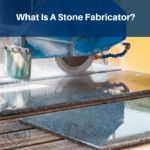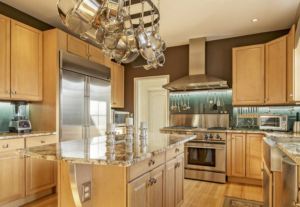
Choosing your countertops is a major decision, both for your bathroom(s), and your kitchen. This doesn’t just go for the material you choose, but also the contractor you pick to have it made and installed. Like any other major choice in dealing with your home, it’s best to be as informed as possible going in.
With countertops, the fabrication process (especially for stone) is actually a very involved mix of art and science, and honestly, it’s quite fascinating to see what goes into this. Understanding how it’s made will help you make proper analyses of quotes, and in fully appreciating the beautiful work that winds up done.
Let’s take a basic look at the step by step fabrication process of stone countertops today. It’s high time the wonderfully skilled artisans whom do this for a profession, had their magic more widely known!
Slab Inspection
To get the beautiful, elegant, organic stone surfaces of modern kitchens and bathrooms, it all starts with a slab of stone, and a very strict inspection. Stone has personality, and the many marks, patterns, colors, and compositions tell a story of where it was queried, and the type of ambience they will provide when installed in a space.
As a customer, you will be shown many slabs of stone, from which you will choose the one that speaks to you the most. But, a skilled expert in this stone will do a follow up inspection, to be sure its initial integrity and solidity is there. Areas that have undesirable markings, weaknesses or blemishes will be marked off as “do not use”, before the next step, templating.
Templating
After inspection, a series of templates will be laid out across the slab, which indicate the different sections that must be cut, to form the various pieces for a complete counter system in a given room. This requires a good eye for flow, mark matching, and optimal space usage, so it’s one of the most mathematically-painstaking stages in this process.
It becomes more complex as they must work these layouts, while avoiding those previously marked off areas intended to be rejected. In rare cases, a chosen template, and a chosen stone, may not work due to an excess of rejected sections, and you may be asked to come in and choose a different slab. This is rare, though.
Stone Cutting
Stone cutting has been romanticized in old movies, showing strapping people with hammers and chisels, but times have definitely changed. Your slab will be cut using either a bridge saw, or a water jet. It may be hard to imagine a water jet able to cut granite, marble or travertine, but high-pressure, focused water is a powerful force.
However, bridge saws, which are diamond-tipped, super-strong metal, are the more common approach, and are descended from an ancient two-man saw that used sand as cutting catalyst.
Fabrication
This stage is a bit of a misnomer, as this is actually the stage where cut-outs for faucets, sinks and other special modifications are made. This is done with a CNC (Computer Numerically Controlled) system, programmed to make cuts in specific places. This requires a skilled operator, as the computer cannot make minor adjustments and judgments on its own. It is the paint brush, not the painter.
Strengthening
There will be some components that are naturally a bit thinner/narrower. Obviously, these will be weaker components, prone to fractures at some point. Strengthening involves drilling rod tunnels through these, through which reinforcement materials can be applied. This will increase the strength of these pieces by up to 400%.
Polishing
Once all cuts are made, polishing is done, which is done through another CNC machine, through a seven-step process of increasing-grit pads.
Seam Phantom
This process is involves going along edges, removing chipping to produce a seam micrometers in tightness and accuracy. This takes a true artist to do right.
Sealing
While granite is mostly impervious to stains and absorption, an additional layer of seal can increase this significantly. This does need replacing every couple decades or so.
QA & Finishing
Finally, the work to this point is once more inspected, before the involved process of hand-finishing is done. Using a series of specialized tools, edges and details are applied to the cut pieces, to produce the final aesthetic, ready to be installed in your home.
To learn more about stone countertops, fill out our contact form below!






